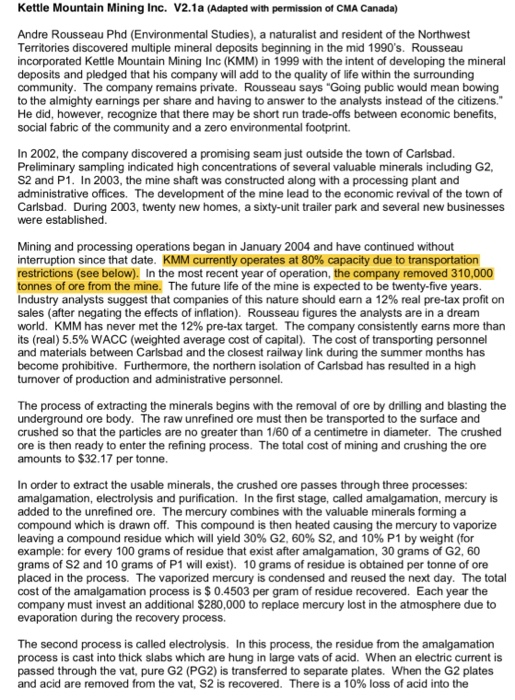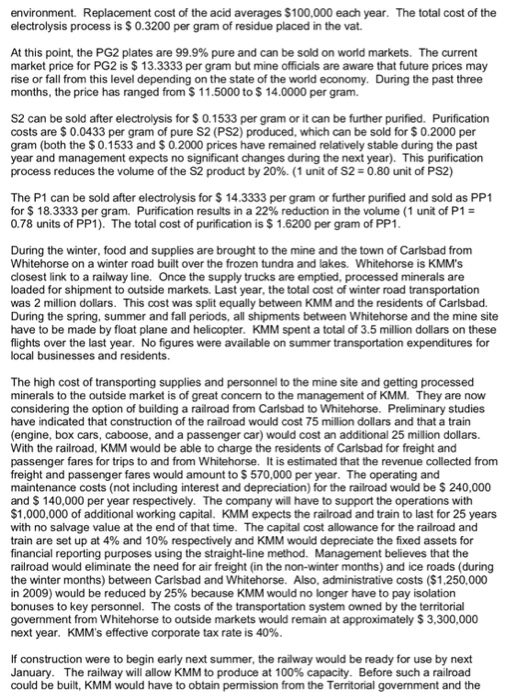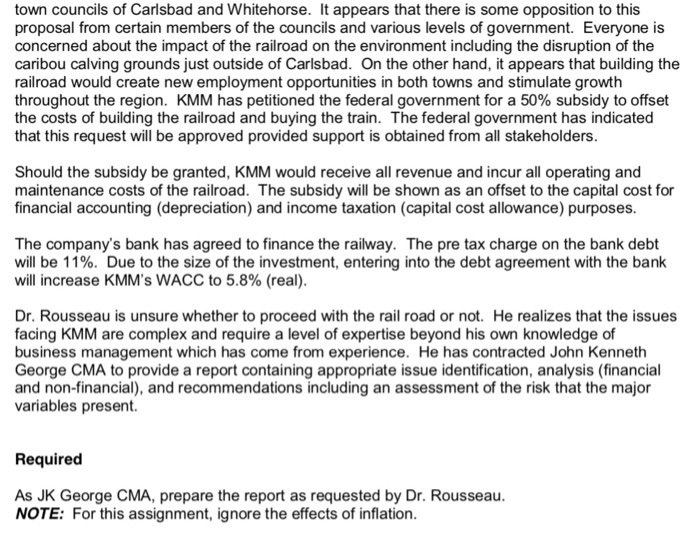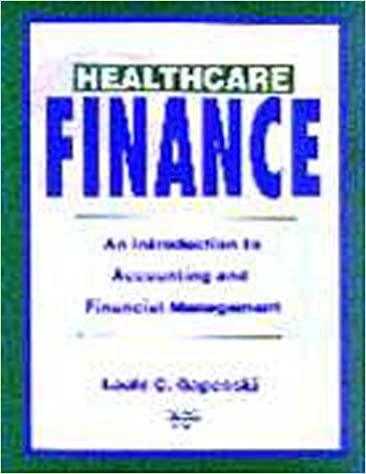It is a bit long, but I really need help with this case. Thanks a lot

Kettle Mountain Mining Inc. V2.1a (Adapted with permission of CMA Canada) Andre Rousseau Phd (Environmental Studies), a naturalist and resident of the Northwest Territories discovered multiple mineral deposits beginning in the mid 1990's. Rousseau incorporated Kettle Mountain Mining Inc (KMM) in 1999 with the intent of developing the mineral deposits and pledged that his company will add to the quality of life within the surrounding community. The company remains private. Rousseau says "Going public would mean bowing to the almighty earnings per share and having to answer to the analysts instead of the citizens. He did, however, recognize that there may be short run trade-offs between economic benefits, social fabric of the community and a zero environmental footprint. In 2002, the company discovered a promising seam just outside the town of Carlsbad Preliminary sampling indicated high concentrations of several valuable minerals including G S2 and P1. In 2003, the mine shaft was constructed along with a processing plant and administrative offices. The development of the mine lead to the economic revival of the town of Carlsbad. During 2003, twenty new homes, a sixty-unit trailer park and several new businesses were established Mining and processing operations began in January 2004 and have continued without interruption since that date. KMM currently operates at 80% capacity due to transportation restrictions (see below). In the most recent year of operation, the company removed 310,000 tonnes of ore from the mine. The future life of the mine is expected to be twenty-five years. Industry analysts suggest that companies of this nature should earn a 12% real pre-tax profit on sales (after negating the effects of inflation). Rousseau figures the analysts are in a dream world. KMM has never met the 12% pre-tax target. The company consistently earns more than its (real) 5.5% WACC (weighted average cost of capital). The cost of transporting personnel and materials between Carlsbad and the closest railway link during the summer months has become prohibitive. Furthermore, the northern isolation of Carlsbad has resulted in a high tunover of production and administrative personnel. The process of extracting the minerals begins with the removal of ore by drilling and blasting the underground ore body. The raw unrefined ore must then be transported to the surface and crushed so that the particles are no greater than 1/60 of a centimetre in diameter. The crushed ore is then ready to enter the refining process. The total cost of mining and crushing the ore amounts to $32.17 per tonne In order to extract the usable minerals, the crushed ore passes through three processes: amalgamation, electrolysis and purification. In the first stage, called amalgamation, mercury is added to the unrefined ore. The mercury combines with the valuable minerals forming a compound which is drawn off. This compound is then heated causing the mercury to vaporize leaving a compound residue which will yield 30% G2.60% S2, and 10% P1 by weight (for example: for every 100 grams of residue that exist after amalgamation, 30 grams of G2, 60 grams of S2 and 10 grams of P1 will exist) 10 grams of residue is obtained per tonne of ore placed in the process. The vaporized mercury is condensed and reused the next day. The total cost of the amalgamation process is $ 0.4503 per gram of residue recovered. Each year the company must invest an additional $280,000 to replace mercury lost in the atmosphere due to evaporation during the recovery process. The second process is called electrolysis. In this process, the residue from the amalgamation process is cast into thick slabs which are hung in large vats of acid. When an electric current is passed through the vat, pure G2 (PG2) is transferred to separate plates. When the G2 plates and acid are removed from the vat, S2 is recovered. There is a 10% loss of acid into the Kettle Mountain Mining Inc. V2.1a (Adapted with permission of CMA Canada) Andre Rousseau Phd (Environmental Studies), a naturalist and resident of the Northwest Territories discovered multiple mineral deposits beginning in the mid 1990's. Rousseau incorporated Kettle Mountain Mining Inc (KMM) in 1999 with the intent of developing the mineral deposits and pledged that his company will add to the quality of life within the surrounding community. The company remains private. Rousseau says "Going public would mean bowing to the almighty earnings per share and having to answer to the analysts instead of the citizens. He did, however, recognize that there may be short run trade-offs between economic benefits, social fabric of the community and a zero environmental footprint. In 2002, the company discovered a promising seam just outside the town of Carlsbad Preliminary sampling indicated high concentrations of several valuable minerals including G S2 and P1. In 2003, the mine shaft was constructed along with a processing plant and administrative offices. The development of the mine lead to the economic revival of the town of Carlsbad. During 2003, twenty new homes, a sixty-unit trailer park and several new businesses were established Mining and processing operations began in January 2004 and have continued without interruption since that date. KMM currently operates at 80% capacity due to transportation restrictions (see below). In the most recent year of operation, the company removed 310,000 tonnes of ore from the mine. The future life of the mine is expected to be twenty-five years. Industry analysts suggest that companies of this nature should earn a 12% real pre-tax profit on sales (after negating the effects of inflation). Rousseau figures the analysts are in a dream world. KMM has never met the 12% pre-tax target. The company consistently earns more than its (real) 5.5% WACC (weighted average cost of capital). The cost of transporting personnel and materials between Carlsbad and the closest railway link during the summer months has become prohibitive. Furthermore, the northern isolation of Carlsbad has resulted in a high tunover of production and administrative personnel. The process of extracting the minerals begins with the removal of ore by drilling and blasting the underground ore body. The raw unrefined ore must then be transported to the surface and crushed so that the particles are no greater than 1/60 of a centimetre in diameter. The crushed ore is then ready to enter the refining process. The total cost of mining and crushing the ore amounts to $32.17 per tonne In order to extract the usable minerals, the crushed ore passes through three processes: amalgamation, electrolysis and purification. In the first stage, called amalgamation, mercury is added to the unrefined ore. The mercury combines with the valuable minerals forming a compound which is drawn off. This compound is then heated causing the mercury to vaporize leaving a compound residue which will yield 30% G2.60% S2, and 10% P1 by weight (for example: for every 100 grams of residue that exist after amalgamation, 30 grams of G2, 60 grams of S2 and 10 grams of P1 will exist) 10 grams of residue is obtained per tonne of ore placed in the process. The vaporized mercury is condensed and reused the next day. The total cost of the amalgamation process is $ 0.4503 per gram of residue recovered. Each year the company must invest an additional $280,000 to replace mercury lost in the atmosphere due to evaporation during the recovery process. The second process is called electrolysis. In this process, the residue from the amalgamation process is cast into thick slabs which are hung in large vats of acid. When an electric current is passed through the vat, pure G2 (PG2) is transferred to separate plates. When the G2 plates and acid are removed from the vat, S2 is recovered. There is a 10% loss of acid into the










